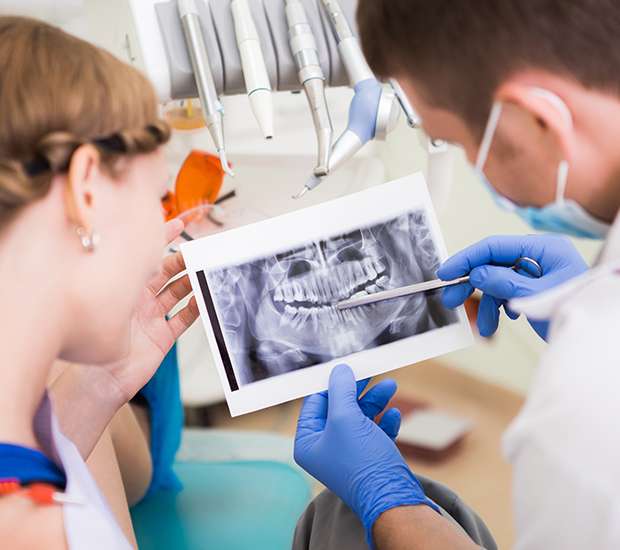
Will I Need a Bone Graft for Dental Implants
Phoenix, AZ
If you are considering getting dental implants, you are already on the road to restoring your smile. Since dental implants are surgically placed and inserted into the jawbone, one of the questions our Phoenix patients ask is whether or not they will need a bone graft prior to the procedure. We encourage you to visit our dental office for an examination and X-rays so that we can answer this question based on your health. You can schedule an appointment by calling (602) 755-6684. In the meantime, here are some answers to frequently asked questions about the bone graft procedure. Call us now.
What is bone augmentation?
Bone augmentation can be performed multiple ways but the purpose of the procedure is to augment or build bone so that your jawbone becomes denser and stronger.
Why does the jawbone lose density in the first place?
This is typically due to resorption. Within the first year of tooth loss you can lose up to 25 percent of your bone density in that particular area. It only continues from there. That is because teeth and roots provide stimulation to the jawbone and that stimulation is a signal to the brain that your jaw is serving its primary purpose. When teeth fall out, that stimulation is reduced or eliminated completely. As a result, the body begins to leach calcium from the jaw for use elsewhere. If you know that you are going to lose a tooth, do not hesitate to schedule an appointment since there are certain procedures that can prevent or limit the amount of resorption.
Other reasons for a loss of bone density is periodontal (gum) disease, developmental defect, injury or decay and infections. Visiting the dentist in Phoenix, AZ on a regular basis for preventative care can help to reduce these risks.
When is bone grafting necessary for dental implants?
Whether or not you will need a bone graft for dental implants depends on the condition of your jawbone and the specific requirements of your dental implant treatment plan. Here are some factors to consider:
- Bone Density:Adequate bone density and volume are essential for the successful placement and stability of dental implants. If your jawbone lacks sufficient bone density due to factors such as tooth loss, gum disease, or resorption, a bone graft may be necessary to augment the bone volume and provide a solid foundation for the implants.
- Sinus Augmentation: In cases where the upper jawbone lacks adequate height or density, particularly in the posterior region, sinus augmentation or sinus lift may be required. This involves lifting the sinus membrane and placing bone graft material in the space created to enhance bone volume for implant placement.
- Ridge Preservation:Following tooth extraction, the alveolar ridge (the bone ridge that supports the teeth) may undergo resorption or shrinkage over time. Ridge preservation techniques, including bone grafting, may be performed at the time of extraction to maintain or augment the bone volume and facilitate future implant placement.
- Evaluation by Your Dentist:Your dentist or oral surgeon will evaluate your jawbone structure and assess the need for bone grafting during the initial consultation for dental implant treatment. This may involve dental imaging techniques such as X-rays, CT scans, or 3D cone beam imaging to evaluate bone quality and quantity.
- Alternative Treatment Options:In some cases, alternative treatment options such as mini dental implants or zygomatic implants may be considered for patients with insufficient bone volume or density to support traditional dental implants without the need for bone grafting.
Ultimately, the decision to undergo bone grafting for dental implants will depend on your individual circumstances, including the condition of your jawbone, the number and location of implants needed, and your overall oral health. Your dentist will work closely with you to develop a personalized treatment plan that addresses your needs and ensures the long-term success of your dental implant treatment.
Whose bone is used for the actual graft?
Your own bone can be used or processed bone may be used. Additionally, there are some newer technologies that may not require bone at all but can work to actually transform cells into bone. However, this is new technology and may not work for everyone.
What happens before the procedure?
Images will need to be taken of your bone so that the dentist in 85053 and surgeon can create a plan for how to augment it. This is typically done using a CT scan. Additionally, you will need to decide whether you want to use processed bone or have bone taken from somewhere else in your body.
What is the bone grafting procedure like?
Most likely you will be put to sleep for this procedure. No matter what, the area will be numbed with anesthesia. This applies to your gums and to any area from which bone is being removed. Next, an incision will be made in your gum tissue and a flap created so that your bone is visible. This allows the surgeon to identify exactly how much bone needs to be placed there. If bone is being taken from somewhere else, an incision will be made so that the bone can be extracted at this time. Grafting material will be placed where the bone once was and that area will be stitched up. Next, the new bone will be anchored to your jawbone using a titanium screw. Other grafting material may be used to surround that new block of bone. Some surgeons may also place membrane material around the bone graft. Afterward, the area will be closed and sutured.
Check out what others are saying about our oral health support services on Yelp: Why Are My Gums Bleeding? Phoenix
What is the recovery time and how will I feel afterwards?
Immediately following your bone grafting procedure you will be very sore. To combat this, you will want to take ibuprofen and use ice packs for fifteen minutes at a time. You will also be given antibiotics to take and want to use an antibacterial mouthwash to prevent an infection. It is essential that you keep pressure off of the area and are careful with what you eat for several weeks.
For the process to be complete it takes several months, usually six to nine. This is because your body will either be building new bone around the grafting material or fusing your jawbone with the bone that was added from somewhere else in your body. Naturally this is a slower process but once complete, your dental implants can be placed and they should be far more secure as a result.
Is this a common dental procedure?
This is a highly specialized procedure that is only performed by certain dentists. This is why you may visit one dentist for a bone grafting procedure and another for dental implants.
Are there alternative options?
Yes. Some dentists offer mini dental implants. These implants are not for everyone. However, they can work well if you have limited density in your jawbone but are not interested in having a bone grafting procedure. These implants are shorter and wider, making them an alternative for those suffering from resorption. Call us to learn more.





